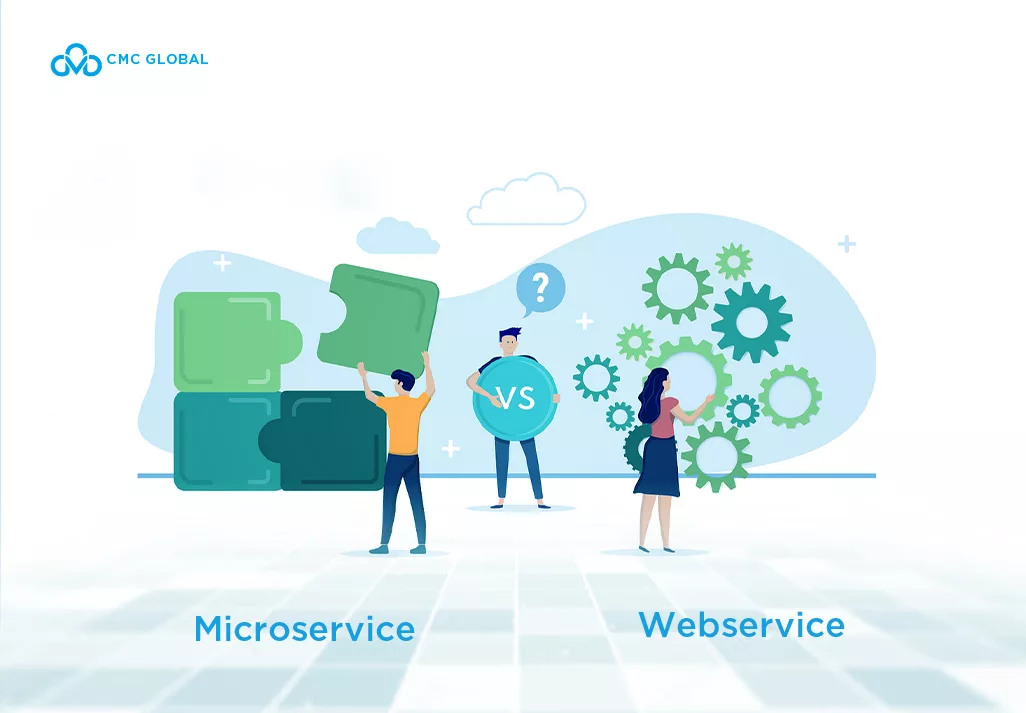Introduction:
Web services are a crucial aspect of the web application development domain. Nevertheless, a new concept has surfaced in the last decade, known as microservices. Microservices refer to compact and specialized code segments intended to perform specific tasks proficiently.
Discover the distinctions between web services and microservices by continuing to read.
Definition:
Initially, it may be challenging to distinguish between microservices and web services since they appear quite similar. Both are classified as API representation tools, which means they are methods of transmitting and distributing data through APIs.
Some basic definitions may include:
Microservices’ Definition:
A microservice is a tiny, independent program that provides a specialized function within a broader application infrastructure.
Web Services’ Definition:
A web service refers to an approach for enabling one application’s services to be accessible to other applications via a web-based interface.
So:
When you compare microservices and web services by such definitions, they may appear similar in function. That’s because web services are a type of microservice that operates exclusively on the web and other online services.

Microservices vs Web Services
On a higher level:
Microservices:
In cases where large applications falter or go down, the microservices architecture can come to the rescue.
If a communication failure occurs in a specific service, it won’t impact the overall application since it’s only one module that’s failed. Microservices can be used in combination with Java, C#, Python, and other mobile software development languages. They can be deployed independently in service models for a specific business domain.
Microservices’ Examples:
Several well-known companies have incorporated microservices into their business practice, including:
- eBay: whose core app consists of autonomous apps executing multi-function business logic
- Netflix: similarly, the previous monolithic architecture transited into hundreds of enabling microservices for handling over a billion API requests a day.
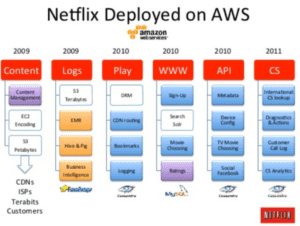
Netflix’s gradual transition to microservices
- Walmart: adopted microservices after experiencing poor user experience due to their old website architecture’s inability to handle millions of page views per minute on Black Friday. They had zero downtime after re-platforming.
Types of Web Services:
Typically, two types of web services are prevalent, namely SOAP and REST. Below is a brief overview:
- SOAP (Simple Object Access Protocol) is an XML-based protocol that encapsulates web service messages sent via the Internet. It employs the HTTP protocol to exchange data and adheres to specific standards for security and address. SOAP is primarily intended for actions.
On the other hand,
- REST (Representational State Transfer) is a software architectural style that is resource-focused. It employs URLs to locate resources and relies solely on HTTP. Interaction with resources in a REST system is based on four basic HTTP verbs: GET, POST, PUT, and DELETE.
Web Services’ Examples:
Web Services provide an object-oriented web interface to a database server and can be used by web servers or mobile applications. They can also be used to create mash-ups by combining content from multiple web services into a single user interface.
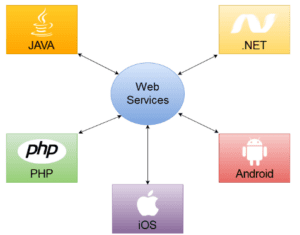
Web Services Examples
Microservices & Web Services Difference:
Although it’s not uncommon to see applications that use both microservices and web services, their purposes differ. The primary point to understand is that microservices and web services address distinct aspects of contemporary application development.
Despite their similarities, microservices and web services are not interchangeable, and the most significant distinction lies in their approach to constructing application architectures.
Below, we’ll examine their distinct architectural styles.
Architecture:
Microservices Application Architecture:
- A modular, services-oriented application architecture comprised of loosely connected, independently running microservices.
- These microservices usually offer APIs (Application Programming Interfaces), so other microservices and apps can integrate with them.
The microservice architecture empowers developers to create applications as a collection of tiny, separate services that can be deployed and scaled independently of each other.
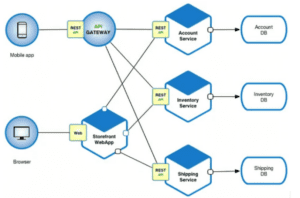
Microservices Application Architecture
Web Services Application Architecture:
- A modular, services-oriented application architecture where the applications that comprise the architecture connect via web services. D
- Developers can use web services to connect microservices, monolithic applications, and more to form a larger application.
A web service collects open protocols and standards for exchanging data between applications or systems. Various devices can use web services, including computers, mobiles, and sensors.
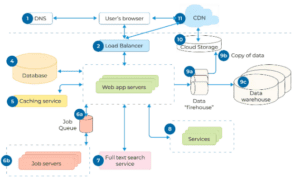
Web Services Application Architecture
Any other words:
It’s typical for contemporary services-orientated application architectures to incorporate both microservices and monolithic applications. Furthermore, it’s common for them to use a blend of APIs and web services to link the applications and microservices that make up their architecture.
Advantages:
Microservices:
-
Flexibility:
Microservices offer improved portability across various platforms and environments due to their ability to be easily deployed on containers. Such APIs are favored for linking microservices due to their capability to support a broad range of message protocols, including HTTPS, HTTP, MQTT, REST, SOAP, and message formats such as XML, XML-RPC, JSON, and more. This versatility in message formats and protocols makes microservices and the microservices application architecture very popular among developers.
Similarly, Microservices enable different teams to work independently and concurrently, reducing inter-department dependencies due to their small size and agile autonomy.
-
Independence:
In a microservice architecture, each feature functions autonomously and deploys services, leading to quicker decision-making. As microservices operate independently, so if one fails, the others can still function.
-
Scalability:
Are relatively more effortless and more efficient due to their elastic nature, as each service can dynamically scale according to demand.
Web Services:
-
Interoperability
Web services provide reliable and automated connections between software applications
-
Service Specificity
A web service can provide multiple services from one application, making it easier to organize access to these services. For example, an e-commerce application could use one web service for customer-facing services and another for inventory services. These services belong to the same application, and web services can help manage and control access to them.
-
Effortlessness & Affordability
Web services have several advantages, including revealing the existing function of the framework, easy implementation, and ease of use due to their conveyance over standard internet technology. They also use XML for data depiction and transportation, resulting in low communication costs.
Disadvantages:
On forward with the disadvantages, these two types may showcase the following demerits:
Microservices:
-
Complexness:
Microservices are more complex than monolithic applications, as they have more components and interactions. Additionally, dealing with such a multitude of databases can be a time-consuming process.
Lastly, Testing the Microservices can be cumbersome & complicated, mainly because of their distributed nature. As the components are distributed, developers can not test an entire system from a single machine.
-
Specialized Machine Requirement:
With a large number of APIs critical to enterprise operations, interface control becomes essential.
Additionally, sufficient hosting infrastructure, security, and maintenance support are required, which necessitates a large and skilled staff, including development teams.
-
Customization:
Customizing initial monolithic software is a challenge when decentralizing. Some components require reprogramming and providing them so, consequently, web services are a far superior solution.
Turning to Web Services,
Web Services:
-
Specialized Machine Requirement:
Resulting in delays in diverse customer management.
Most internet users are aware that websites may not be accessible at all times, which often necessitates the development of a mechanism to retry transactions.
Additionally, currently, in its iteration, the SOAP process does not support the transaction process.
-
Security:
Web services are publicly available via HTTP-based protocols, which is a significant weakness of web services, as it compromises their security.
Which to Choose:
To sum up, below is a listed comparing chart to simplify your decision-making process.
| No. | Microservices | Web Services |
|
|
Executed via a web service. | For providing services |
|
|
Horizontal approach & natural disposition. | Vertical nature |
|
|
An autonomous single-purpose application belonged to a larger application | Service facilitator for availability across the web-based interface. |
|
|
More complicated yet compact. | Simpler |
|
|
Limited and bounded sharing context | Allowed components’ sharing |
So:
The decision on which option to choose ultimately depends on your particular requirements. If you want a more lightweight and separate solution, microservices may be the way to go.
However, if you require a more comprehensive and unified solution, web services may be a better choice.
Conclusion:
In conclusion, microservices and web services are two distinct approaches to developing web applications, both facilitating communication between different applications. Web services rely on a centralized network, while microservices rely on a distributed network.
In this article, the different API representation tools and their performance in specific situations are examined. The most important factor in choosing the right architecture is always the project’s requirements. It’s important to keep in mind the application’s objective before deciding on a specific architecture.
A WS is suitable for sophisticated software solutions that require network connectivity and work well in larger corporate settings.
Microservices architecture is ideal for smaller web-based applications that are well-structured. It provides greater control and is preferred by designers building web or mobile applications.
In conclusion, microservices and web services have distinct objectives and represent different architectural styles for different successful both individuals and combined software solutions. Contact us for further consultation!
